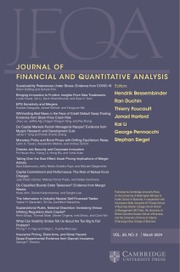Article contents
Variance Decomposition and Cryptocurrency Return Prediction
Published online by Cambridge University Press: 15 April 2024
Abstract
This article examines how realized variances predict cryptocurrency returns in the cross section using intraday data. We find that cryptocurrencies with higher variances exhibit lower returns in subsequent weeks. Decomposing total variances into signed jump and jump-robust variances reveals that the negative predictability is attributable to positive jump and jump-robust variances. The negative pricing effect is more pronounced for smaller cryptocurrencies with lower prices, less liquidity, more retail trading activities, and more positive sentiment. Our results suggest that cryptocurrency markets are unique because retail investors and preferences for lottery-like payoffs play important roles in the partial variance effects.
Information
- Type
- Research Article
- Information
- Creative Commons
- This is an Open Access article, distributed under the terms of the Creative Commons Attribution-NonCommercial-ShareAlike licence (http://creativecommons.org/licenses/by-nc-sa/4.0), which permits non-commercial re-use, distribution, and reproduction in any medium, provided the same Creative Commons licence is used to distribute the re-used or adapted article and the original article is properly cited. The written permission of Cambridge University Press must be obtained prior to any commercial use.
- Copyright
- © The Author(s), 2024. Published by Cambridge University Press on behalf of the Michael G. Foster School of Business, University of Washington
Footnotes
We thank Dexin Zhou, Olivier Scaillet, Fabio Trojani, Narayan Jayaraman, Sudheer Chava, and seminar participants at the University of Geneva, the University of Georgia, Baruch College, Australian Finance and Banking Conference, Midwest Finance Association annual meeting, SKKU International Conference, and Joint Conference with the Allied Korea Finance Associations for their helpful discussions, comments, and encouragement. We particularly thank George Pennacchi (the editor) and an anonymous referee for their constructive suggestions and comments.
References
- 3
- Cited by

